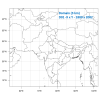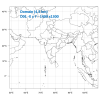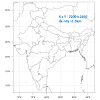Dear WRF Team,
I hope this email finds you well. My name is Saikrishna, and I am currently engaged in the simulation of heavy rainfall events over India using the WRF model. My objective is to analyze both local-scale and large-scale features during these events.
In my endeavor, I have attempted to simulate the events utilizing both single-domain (with resolutions of 3km, 1.5km, and 1km) and nested-domain setups (with resolutions of 6x3km and 2.5x1.5km). Encouragingly, the simulation with a single domain (4.5km resolution) proved successful.
To ensure accuracy, I meticulously designed the domain boundaries to avoid any coincidences with complex topographical features. However, upon attempting resolutions finer than 4.5km, I encountered a recurring "Segmentation fault" error.
After thorough research, I identified several potential causes for this error, including:
Your guidance and insights would be immensely valuable in advancing my research. I eagerly await your response.
Thank you for your time and consideration.
I hope this email finds you well. My name is Saikrishna, and I am currently engaged in the simulation of heavy rainfall events over India using the WRF model. My objective is to analyze both local-scale and large-scale features during these events.
In my endeavor, I have attempted to simulate the events utilizing both single-domain (with resolutions of 3km, 1.5km, and 1km) and nested-domain setups (with resolutions of 6x3km and 2.5x1.5km). Encouragingly, the simulation with a single domain (4.5km resolution) proved successful.
To ensure accuracy, I meticulously designed the domain boundaries to avoid any coincidences with complex topographical features. However, upon attempting resolutions finer than 4.5km, I encountered a recurring "Segmentation fault" error.
After thorough research, I identified several potential causes for this error, including:
- Improper processor allocation or excessive processor utilization during decomposition
- Storage and memory constraints (addressed by setting [ulimit -s unlimited])
- Input data inaccuracies
- CFL (Courant-Friedrichs-Lewy) instability issues, potentially mitigated by adjusting the time step
- Parameter adjustments such as Etac values (0.0001, 0.01, 0.02, and 0.05) and Epssm range (0.2 – 0.9)
Your guidance and insights would be immensely valuable in advancing my research. I eagerly await your response.
Thank you for your time and consideration.



